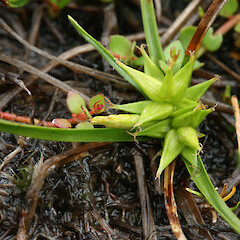Carex carsei
Common name
Carse’s sedge
Synonyms
None
Family
Cyperaceae
Flora category
Vascular – Native
Endemic taxon
Yes
Endemic genus
No
Endemic family
No
Structural class
Sedges
NVS code
The National Vegetation Survey (NVS) Databank is a physical archive and electronic databank containing records of over 94,000 vegetation survey plots - including data from over 19,000 permanent plots. NVS maintains a standard set of species code abbreviations that correspond to standard scientific plant names from the Ngä Tipu o Aotearoa - New Zealand Plants database.
CRXCAR
Chromosome number
2n = 36
Current conservation status
The conservation status of all known New Zealand vascular plant taxa at the rank of species and below were reassessed in 2017 using the New Zealand Threat Classification System (NZTCS) – more information about this can be found on the NZTCS website. This report includes a statistical summary and brief notes on changes since 2012 and replaces all previous NZTCS lists for vascular plants.
Please note, threat classifications are often suggested by authors when publications fall between NZTCS assessment periods – an interim threat classification status has not been assessed by the NZTCS panel.
- Conservation status of New Zealand indigenous vascular plants, 2017 . 2018. Peter J. de Lange, Jeremy R. Rolfe, John W. Barkla, Shannel P. Courtney, Paul D. Champion, Leon R. Perrie, Sarah M. Beadel, Kerry A. Ford, Ilse Breitwieser, Ines Schönberger, Rowan Hindmarsh-Walls, Peter B. Heenan and Kate Ladley. Department of Conservation. Source: NZTCS and licensed by DOC for reuse under the Creative Commons Attribution 4.0 International licence.
2017 | At Risk – Declining | Qualifiers: DP
Previous conservation statuses
2012 | At Risk – Naturally Uncommon | Qualifiers: DP
2009 | At Risk – Declining | Qualifiers: DP
2004 | Data Deficient
Distribution
Endemic. In the North Island known from near Lake Taupo, and wetlands around Tongariro National Park. In the South Island throughout in suitable habitats, though scarce in Canterbury, Otago and Fiordland.
Habitat
A subalpine to alpine sedge of boggy ground, mires, and wet forest clearings.
Wetland plant indicator status rating
Information derived from the revised national wetland plant list prepared to assist councils in delineating and monitoring wetlands (Clarkson et al., 2021 Manaaki Whenua – Landcare Research Contract Report LC3975 for Hawke’s Bay Regional Council). The national plant list categorises plants by the extent to which they are found in wetlands and not ‘drylands’. The indicator status ratings are OBL (obligate wetland), FACW (facultative wetland), FAC (facultative), FACU (facultative upland), and UPL (obligate upland). If you have suggestions for the Wetland Indicator Status Rating, please contact: [Enable JavaScript to view protected content]
OBL: Obligate Wetland
Almost always is a hydrophyte, rarely in uplands (non-wetlands).
Detailed description
Rhizomatous sedge, forming dense, grassy swards in swampy places. Rhizomes 1 mm diameter, light brown or grey. Culms 2.5–8.5–(25) cm × 0.5–1 mm, 3-angled (trigonous) or compressed below, stiff, erect, hairless, enclosed for much of length by grey or cream leaf-sheaths. Leaves much > culms, 1–2.5 mm wide, channelled, grass-like, yellow-green, linear, narrowed to a subobtuse tip, margins finely scabrid (toothed). Inflorescence of 3–5 spikes, clustered together in a compact head, terminal spike male, small, unstalked, remaining spikes female, stalked, overtopping male 1–1.5 cm long. Glumes much < than utricles, broadly ovate, acute, membraneous, faintly multi-nerved, pale yellow-brown with a green midrib. Utricles 7–8.5 × 2 mm, plano(flat)-convex to subtrigonous, narrowly lanceolate, multi-nerved, light green to greenish-brown, hairless, tapering to a 3–3.5 mm long beak. Beak bifid, with a finely scabrid orifice. Stigmas 3. Nut 2 mm long, obtusely 3-angled, obovoid, glossy, light yellow-green.
Similar taxa
Carex carsei is a very distinctive species unlikely to confused with any other indigenous or naturalised sedge.
Flowering
No information available
Fruiting
No information available
Propagation technique
Easily grown by division and from fresh seed.
Threats
Carex carsei has very few recent (>1980) collections.
Etymology
carex: Latin name for a species of sedge, now applied to the whole group.
Attribution
Fact Sheet prepared by P.J. de Lange (10 August 2006). Description adapted from Moore and Edgar (1970).
References and further reading
Moore LB, Edgar E. 1970. Flora of New Zealand, Volume II. Indigenous Tracheophyta: Monocotyledones except Gramineae. Government Printer, Wellington, NZ. 354 p.
Thorsen MJ, Dickinson KJM, Seddon PJ. 2009. Seed dispersal systems in the New Zealand flora. Perspectives in Plant Ecology, Evolution and Systematics 11: 285–309.
NZPCN Fact Sheet citation
Please cite as: de Lange, P.J. (Year at time of access): Carex carsei Fact Sheet (content continuously updated). New Zealand Plant Conservation Network. https://www.nzpcn.org.nz/flora/species/carex-carsei/ (Date website was queried)












